Troubleshooting System Restore does not work on Windows 10/8/7
When your computer is stable, is this what you always wanted? Even if you have been very careful with the programs you download, regularly defragment your hard drive and do other things to make sure your computer system runs the best way. However, there are many problems that can arise without warning.
System Restore (System Restore) can work effectively and help your system return to its original state when encountering problems. However, if the System Restore feature does not work, there may be some things to check before you reinstall (Windows). You have made sure that System Restore is turned on, but it still does not work, try the following.
1. Fix System Restore error not working on Windows 10/8/7
When System Restore has an error or problem, some error messages appear on the screen such as:
- System Restore failed.
- Error 0x800423F3: The writer experienced a transient error. Nếu tiến trình sao lưu được lấy lại, gặp lỗi này không thể đăng nhập.
- Không thể tạo một copy shadow cho lý do sau. The writer experienced an error transient (0x800423F3)
- System Restore không thành công successfully. Tập tin hệ thống của tập tin và đặt được không thay đổi
- Không thể hệ thống phục hồi, tập tin hoặc thư mục bị hỏng, and unreadable (0x80070570).
- System Restore bị lỗi khi giải phóng bản sao gốc của thư mục từ chế độ phục hồi.
- Restore point không thể được tạo cho lý do này: Lỗi tìm thấy trong tập tin Volume Shadow Copy (VSS)
In this case, you can refer to some of the following ways to troubleshoot problems and errors:
1. Try to create a System Restore point and note the error message again. If you have not created a backup and restore point, check to see if System Restore was previously created.
2. Disable programs, antivirus software, and security software, then try to create System Restore.
3. Boot in Safe mode and check if you created a new System Restore or restore System Restore earlier. In many cases, non-Microsoft services or drivers may interfere with System Restore's functionality.
Alternatively, you can use Clean Boot and check if you have System restore running.
4. Run System File Checker. Run the sfc / scannow command on the Elevated command prompt window. Then restart and try to create System restore again.
5. Run Check Disk by opening Elevated Command Prompt, entering chkdsk / f / r into it and pressing Enter. Wait until the process is complete and try creating System restore again.
6. Make sure System Restore is enabled on the driver that you want to enable System Restore.
Right-click Computer => Properties => System protection . Check the Protection setting.
To store Restore points you need at least 300 MB of memory space on the hard drive to open System Protection.
7. Make sure there is enough memory space on all drivers so that System Restore is enabled.
8. Enter Services.msc in the Search Start Menu box and press Enter. Ensure that Volume Shadow Copy & Task Scheduler & Microsoft Software Shadow Copy Provider Service are running and are set to Automatic.
If the System Restore Service status is Not Started , you reactivate it as Start . In addition, the mode setting is Automatic if not already set. Restart if required. Confirm again and try System Restore again.
9. Enter eventvwr.msc / s into the Search frame and press Enter to open Event Viewer. Double-click Applications & Services Logs and check the cause of the problem.
10. Check System Administrator if you have System Restore disabled and request to re-enable System Restore.
11. Reset Repository. To reset Repository, follow the steps below:
1. Start in Safe Mode without networking and then open the Command prompt under Admin.
2. Enter net stop winmgmt then press Enter to stop Windows Management Instrumentation Service.
3. Next go to C: WindowsSystem32wbem and rename the repository to repositoryold.
4. Restart your computer.
Re-open the Command Prompt under Admin and then enter net stop winmgmt then press Enter.
Next enter winmgmt / resetRepository and press Enter.
Finally restart your computer.
2. Run System Restore from Safe Mode
If you get any problems while running System Restore, or the System Restore process fails, try running the utility again in Safe Mode . To start Windows in Safe Mode, restart your computer and press F8 (if your computer only has Windows installed). If you have a dual-boot configuration, select Windows and press F8 before the Windows logo appears. You can also set the system to start automatically into Safe Mode by going to Start and typing ' msconfig ' in the search box. In the System Configuration window switch to the Boot tab and check the Safe boot box> Ok .
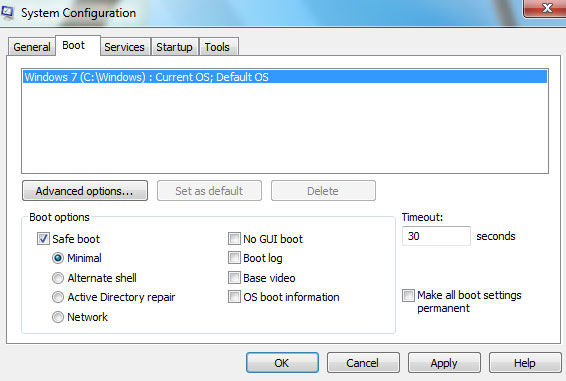
When your desktop is in Windows Safe Mode , click Start and enter System in the search box and select System Restore (or you can enter System Restore and press Enter).
If System Restore works in Safe Mode, you should run this utility right now. Stop antivirus programs and corrupted files (such as turning off Norton's Tamper protection) before performing System Restore.
Sometimes your system files may have been damaged when performing Restore. You may have to use an earlier restore point (especially if you have tried newer ones but failed), but if these actions still don't work, you may need to switch to mode System Restore off (this will delete all current restore points), restart your computer and try again.
3. Configure the hard disk space (300MB)
If the System Restore feature still doesn't work correctly, try adjusting the disk space allocated to System Restore. Microsoft recommends that users leave at least 300MB of free space on the hard disk and actually System Restore can use up to 15% of the capacity, you can consider to increase the allocation space or delete restore points old.
To adjust disk space for System Restore, click Start > enter ' create restore ' in the search box and press Enter when Create a restore point is highlighted.

At the window that appears, click the Configure button.
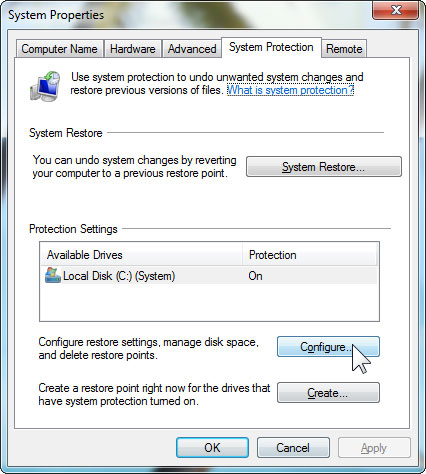
In the next dialog box, move the slider to change the usage in the Max Usage section :
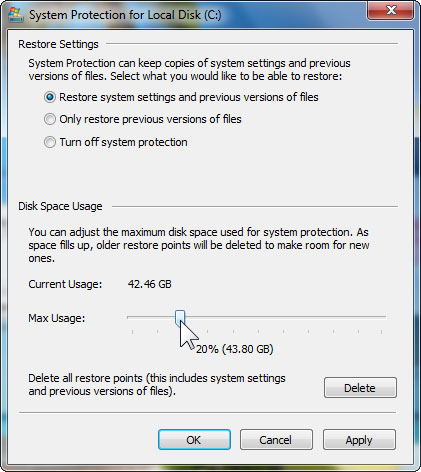
To delete old restore points, you can use the option below the slider to delete all of these and previous versions of the file, or just delete the older restore points while keeping a copy. last most recent. To do so, go to Start and enter Disk Cleanup in the search box, right-click on the first item and select Run as Administrator .
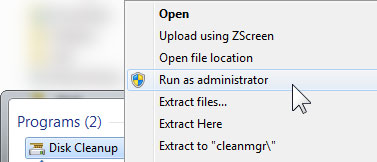
At the window that appears select the More Options tab then select Clean up .
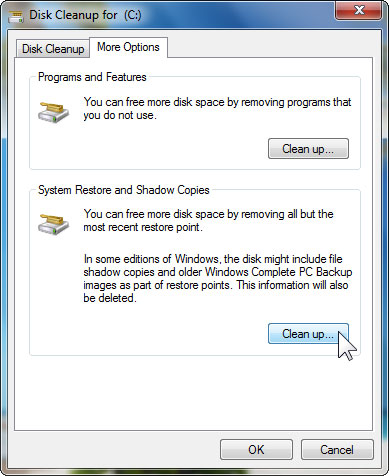
4. Try using the System Image Backup program
System Restore may always work well for you, but if you have tried a lot of ways that System Restore doesn't work completely, try backing up your system image. This process will create a photo of your system when it works stably and smoothly so you can restore this state in case of a problem. Windows 7 has a built-in function for you to create system and image repair discs. Just go to Start, type " repair " or " system repair " in the search box and follow the instructions to create a repair disk.
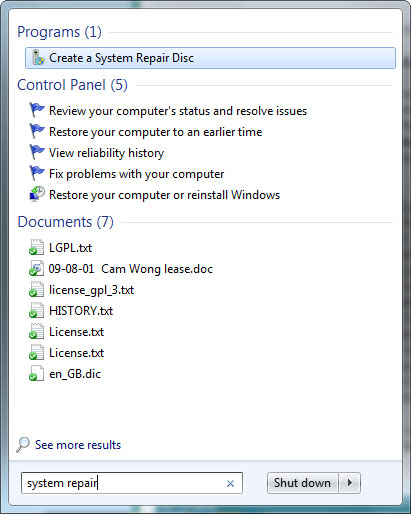
To create an image of the system, enter ' back up ' in the search box and select back up your computer .
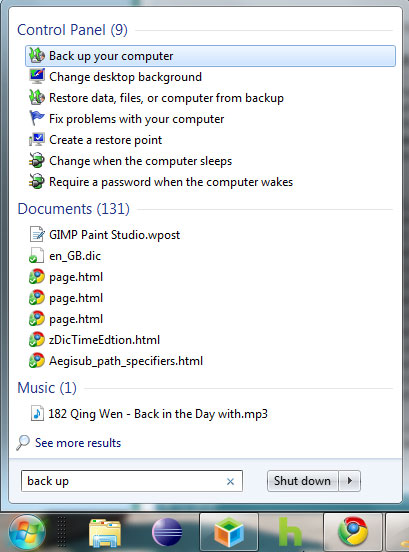
A window will appear. Click on Create a System Image on the left:
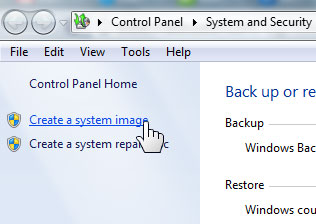
You will be prompted to choose where to save your system image. To restore the backup image, see the simple instructions here (English version).
You can also use Clonezilla, Paragon's Drive Backup Express or any of the 5 excellent tools on this list.
If you want to reinstall Windows, read the instructions here to reinstall without losing your data.
In addition, to be safe you should regularly check whether your computer creates restore points by going to Start , entering ' rstrui ' into the search box, and the dialog box will appear. Click Next and check on the screen to see if there are any recent restore points.
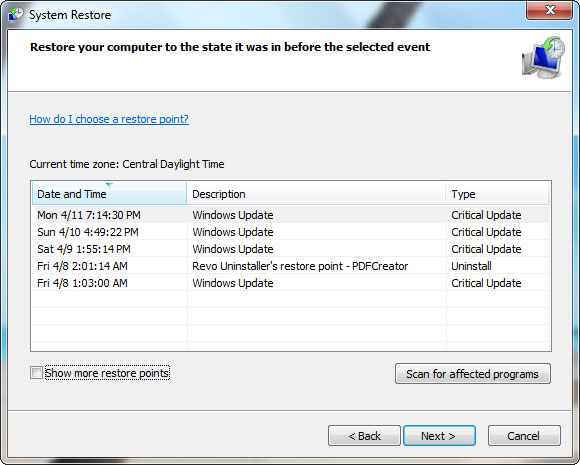
5. Use another Restore point
Use in case of using System Restore you receive an error message.
Click Start, then enter the System Restore keyword there and press Enter to open the System Restore window.
On the System Restore window, select Choose a different restore point and then click Next.

Select the System Restore point you created earlier. Although there are many System Restore points created after the crash, these System Restore points do not support anything.
To see all available Restore points, select Show more restore points on the window.
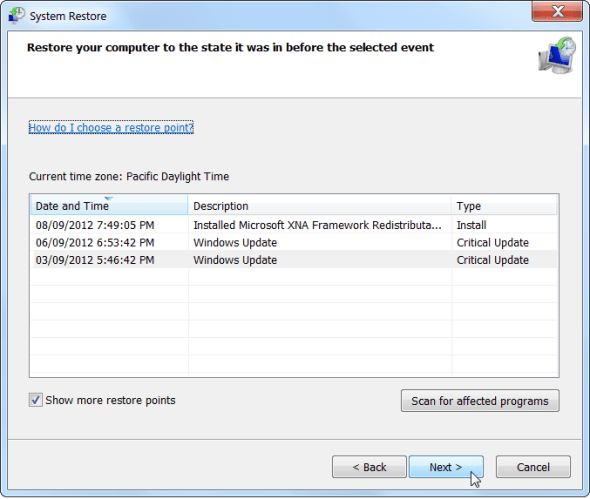
6. Reinstall Windows
If System Restore does not work even in Safe Mode, it is likely that the file has been corrupted. Or if System Restore works but doesn't fix the problem you are experiencing, chances are that the Restore point you created earlier has failed.
In these cases you must restore the operating system on your computer from restoring the partition or reinstalling Windows.
First backup all your personal data - the reinstallation process will wipe all files and programs on your hard drive.
After backing up important files safely, you can restore them in 1 of 3 ways below:
- Most laptops and computers have recovery partitions (recovery partitions), you can activate them by pressing a specific key during the restart of the computer. However, each line of laptop and laptop, the specified keys will be different, so you can refer to the manufacturer's instructions.
- If your computer comes with Restore Discsm instead of Restore Partition, first insert the restore drive into your computer and then restart the computer to start the process. Show the next steps.
- If you install Windows yourself, insert the Windows installation drive into your computer and then start your computer.
Follow the on-screen instructions to complete the restore or reinstall Windows process after starting your computer.
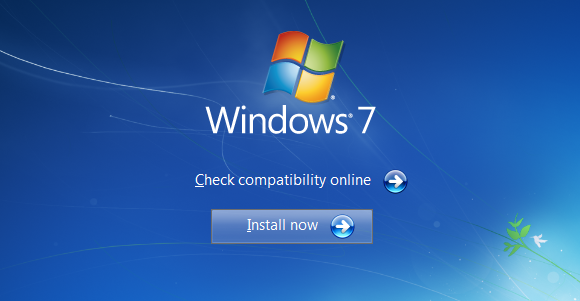
Refer to some of the following articles:
- When and how to defragment hard drives on Windows 10?
- Activate Standard User to run the program under Admin without a password
- Resize virtual memory (Virtual Memory) on Windows operating system
Good luck!
You should read it
- How to use System Restore in Windows: Turn off, turn on, create, restore System Restore
- Configure the System Restore feature in Windows 10
- Instructions for creating backup and restore points (Restore Point) on Windows 10
- 11 ways to open System Restore on Windows 11
- How to Repair Windows 7
- How to Do a System Restore
- How to delete System Restore Points in Windows 10
- Restore previous Windows version from Windows 7
May be interested
- 20 useful troubleshooting tools for Windows 10
 windows provides many troubleshooting and troubleshooting tools. whether your computer has an update, sound or driver error, there are troubleshooting tools to help you. this article covers a series of 'weapons' against common windows problems. some tools must be installed from a third party, a large number of tools come with windows 10 operating system.
windows provides many troubleshooting and troubleshooting tools. whether your computer has an update, sound or driver error, there are troubleshooting tools to help you. this article covers a series of 'weapons' against common windows problems. some tools must be installed from a third party, a large number of tools come with windows 10 operating system. - How to delete System Restore Points in Windows 10
 creating system restore points is a good way to protect your windows 10 data. however, creating multiple system restore points consumes your disk space.
creating system restore points is a good way to protect your windows 10 data. however, creating multiple system restore points consumes your disk space. - How to Manage System Restore Points Using CCleaner (Windows)
 system restore is a wonderful feature that allows you to bypass software issues by restoring your computer without losing any important data. however, a new system restore point is created each time you clean your windows, which can not...
system restore is a wonderful feature that allows you to bypass software issues by restoring your computer without losing any important data. however, a new system restore point is created each time you clean your windows, which can not... - Restore previous Windows version from Windows 7
 this article will show you how to manually restore the previous windows operating system installation to replace the version of windows 7 operating system you are using by using the windows.old folder.
this article will show you how to manually restore the previous windows operating system installation to replace the version of windows 7 operating system you are using by using the windows.old folder. - How to Do a System Restore
 this wikihow teaches you how to restore a previous version of your windows computer's operation. keep in mind that you will need to have a restore point on your computer in order to use system restore. if you want to restore a mac, you'll...
this wikihow teaches you how to restore a previous version of your windows computer's operation. keep in mind that you will need to have a restore point on your computer in order to use system restore. if you want to restore a mac, you'll... - How to delete individual system restore points in Windows
 windows automatically creates system restore points up to a set limit, leaving you with dozens of restore points you never use.
windows automatically creates system restore points up to a set limit, leaving you with dozens of restore points you never use. - Don't miss out on useful tools available on Windows 10!
 the tools built into windows 10 are often overlooked, with little attention paid to. but if you know and can take advantage of it, the operations when working on your computer will be faster, as well as bring many other benefits.
the tools built into windows 10 are often overlooked, with little attention paid to. but if you know and can take advantage of it, the operations when working on your computer will be faster, as well as bring many other benefits. - Part II: Troubleshooting
 when you encounter a bsod error (blue screen of dead), you first need to consider which error group it belongs to in the previous section, but by default windows will automatically restart the system. system when an error occurs.
when you encounter a bsod error (blue screen of dead), you first need to consider which error group it belongs to in the previous section, but by default windows will automatically restart the system. system when an error occurs. - How to Use System Restore on Windows 7
 when you come across a problem on your computer and you cannot seem to fix the issue, using system restore is probably your best bet. the system restore function on windows 7 allows you to roll back your computer to a previous time before...
when you come across a problem on your computer and you cannot seem to fix the issue, using system restore is probably your best bet. the system restore function on windows 7 allows you to roll back your computer to a previous time before... - Complete how to use all backup and restore tools on Windows 10
 windows 10 has many built-in backup and recovery tools so that users can select, exploit and use for the purpose of protecting their data and systems safely. microsoft brought back the windows backup backup tool that has been 'removed' in windows 8.1, the file history function has also been preserved and some backup options on the cloud and other system restore in important cases .
windows 10 has many built-in backup and recovery tools so that users can select, exploit and use for the purpose of protecting their data and systems safely. microsoft brought back the windows backup backup tool that has been 'removed' in windows 8.1, the file history function has also been preserved and some backup options on the cloud and other system restore in important cases .










 Learn about 100MB partition when installing Windows 7/8 / 8.1
Learn about 100MB partition when installing Windows 7/8 / 8.1 50 Registry tricks to help you become a true Windows 7 / Vista 'hacker' (Part 2)
50 Registry tricks to help you become a true Windows 7 / Vista 'hacker' (Part 2) What is a DLL file, and how does this file work?
What is a DLL file, and how does this file work? How to backup and restore Windows in just 10 minutes with Acronis True Image
How to backup and restore Windows in just 10 minutes with Acronis True Image 34 common shortcuts on Windows Command Prompt
34 common shortcuts on Windows Command Prompt Fix Not a Valid Win32 Application error when opening Game on Windows
Fix Not a Valid Win32 Application error when opening Game on Windows